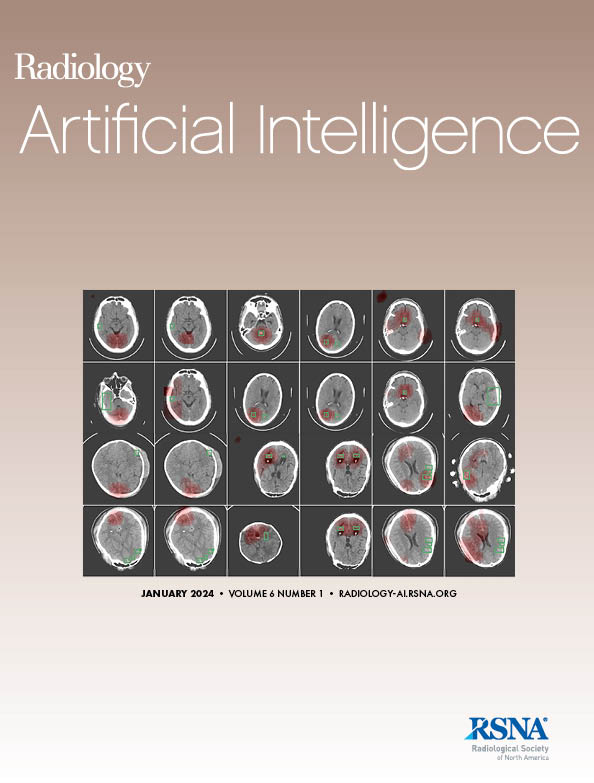Sven Koehler, Julian Kuhm, Tyler Huffaker, Daniel Young, Animesh Tandon, Florian André, Norbert Frey, Gerald Greil, Tarique Hussain, Sandy Engelhardt
下载PDF
{"title":"基于深度学习的Cine心脏MRI对齐应变检测杜氏肌营养不良患者纤维化心肌组织。","authors":"Sven Koehler, Julian Kuhm, Tyler Huffaker, Daniel Young, Animesh Tandon, Florian André, Norbert Frey, Gerald Greil, Tarique Hussain, Sandy Engelhardt","doi":"10.1148/ryai.240303","DOIUrl":null,"url":null,"abstract":"<p><p>Purpose To develop a deep learning (DL) model that derives aligned strain values from cine (noncontrast) cardiac MRI and evaluate performance of these values to predict myocardial fibrosis in patients with Duchenne muscular dystrophy (DMD). Materials and Methods This retrospective study included 139 male patients with DMD who underwent cardiac MRI at a single center between February 2018 and April 2023. A DL pipeline was developed to detect five key frames throughout the cardiac cycle and respective dense deformation fields, allowing for phase-specific strain analysis across patients and from one key frame to the next. Effectiveness of these strain values in identifying abnormal deformations associated with fibrotic segments was evaluated in 57 patients (mean age [± SD], 15.2 years ± 3.1), and reproducibility was assessed in 82 patients by comparing the study method with existing feature-tracking and DL-based methods. Statistical analysis compared strain values using <i>t</i> tests, mixed models, and more than 2000 machine learning models; accuracy, F1 score, sensitivity, and specificity are reported. Results DL-based aligned strain identified five times more differences (29 vs five; <i>P</i> < .01) between fibrotic and nonfibrotic segments compared with traditional strain values and identified abnormal diastolic deformation patterns often missed with traditional methods. In addition, aligned strain values enhanced performance of predictive models for myocardial fibrosis detection, improving specificity by 40%, overall accuracy by 17%, and accuracy in patients with preserved ejection fraction by 61%. Conclusion The proposed aligned strain technique enables motion-based detection of myocardial dysfunction at noncontrast cardiac MRI, facilitating detailed interpatient strain analysis and allowing precise tracking of disease progression in DMD. <b>Keywords:</b> Pediatrics, Image Postprocessing, Heart, Cardiac, Convolutional Neural Network (CNN) Duchenne Muscular Dystrophy <i>Supplemental material is available for this article.</i> © RSNA, 2025.</p>","PeriodicalId":29787,"journal":{"name":"Radiology-Artificial Intelligence","volume":" ","pages":"e240303"},"PeriodicalIF":13.2000,"publicationDate":"2025-05-01","publicationTypes":"Journal Article","fieldsOfStudy":null,"isOpenAccess":false,"openAccessPdf":"https://www.ncbi.nlm.nih.gov/pmc/articles/PMC12127955/pdf/","citationCount":"0","resultStr":"{\"title\":\"Deep Learning-based Aligned Strain from Cine Cardiac MRI for Detection of Fibrotic Myocardial Tissue in Patients with Duchenne Muscular Dystrophy.\",\"authors\":\"Sven Koehler, Julian Kuhm, Tyler Huffaker, Daniel Young, Animesh Tandon, Florian André, Norbert Frey, Gerald Greil, Tarique Hussain, Sandy Engelhardt\",\"doi\":\"10.1148/ryai.240303\",\"DOIUrl\":null,\"url\":null,\"abstract\":\"<p><p>Purpose To develop a deep learning (DL) model that derives aligned strain values from cine (noncontrast) cardiac MRI and evaluate performance of these values to predict myocardial fibrosis in patients with Duchenne muscular dystrophy (DMD). Materials and Methods This retrospective study included 139 male patients with DMD who underwent cardiac MRI at a single center between February 2018 and April 2023. A DL pipeline was developed to detect five key frames throughout the cardiac cycle and respective dense deformation fields, allowing for phase-specific strain analysis across patients and from one key frame to the next. Effectiveness of these strain values in identifying abnormal deformations associated with fibrotic segments was evaluated in 57 patients (mean age [± SD], 15.2 years ± 3.1), and reproducibility was assessed in 82 patients by comparing the study method with existing feature-tracking and DL-based methods. Statistical analysis compared strain values using <i>t</i> tests, mixed models, and more than 2000 machine learning models; accuracy, F1 score, sensitivity, and specificity are reported. Results DL-based aligned strain identified five times more differences (29 vs five; <i>P</i> < .01) between fibrotic and nonfibrotic segments compared with traditional strain values and identified abnormal diastolic deformation patterns often missed with traditional methods. In addition, aligned strain values enhanced performance of predictive models for myocardial fibrosis detection, improving specificity by 40%, overall accuracy by 17%, and accuracy in patients with preserved ejection fraction by 61%. Conclusion The proposed aligned strain technique enables motion-based detection of myocardial dysfunction at noncontrast cardiac MRI, facilitating detailed interpatient strain analysis and allowing precise tracking of disease progression in DMD. <b>Keywords:</b> Pediatrics, Image Postprocessing, Heart, Cardiac, Convolutional Neural Network (CNN) Duchenne Muscular Dystrophy <i>Supplemental material is available for this article.</i> © RSNA, 2025.</p>\",\"PeriodicalId\":29787,\"journal\":{\"name\":\"Radiology-Artificial Intelligence\",\"volume\":\" \",\"pages\":\"e240303\"},\"PeriodicalIF\":13.2000,\"publicationDate\":\"2025-05-01\",\"publicationTypes\":\"Journal Article\",\"fieldsOfStudy\":null,\"isOpenAccess\":false,\"openAccessPdf\":\"https://www.ncbi.nlm.nih.gov/pmc/articles/PMC12127955/pdf/\",\"citationCount\":\"0\",\"resultStr\":null,\"platform\":\"Semanticscholar\",\"paperid\":null,\"PeriodicalName\":\"Radiology-Artificial Intelligence\",\"FirstCategoryId\":\"1085\",\"ListUrlMain\":\"https://doi.org/10.1148/ryai.240303\",\"RegionNum\":0,\"RegionCategory\":null,\"ArticlePicture\":[],\"TitleCN\":null,\"AbstractTextCN\":null,\"PMCID\":null,\"EPubDate\":\"\",\"PubModel\":\"\",\"JCR\":\"Q1\",\"JCRName\":\"COMPUTER SCIENCE, ARTIFICIAL INTELLIGENCE\",\"Score\":null,\"Total\":0}","platform":"Semanticscholar","paperid":null,"PeriodicalName":"Radiology-Artificial Intelligence","FirstCategoryId":"1085","ListUrlMain":"https://doi.org/10.1148/ryai.240303","RegionNum":0,"RegionCategory":null,"ArticlePicture":[],"TitleCN":null,"AbstractTextCN":null,"PMCID":null,"EPubDate":"","PubModel":"","JCR":"Q1","JCRName":"COMPUTER SCIENCE, ARTIFICIAL INTELLIGENCE","Score":null,"Total":0}
引用次数: 0
引用
批量引用

 求助内容:
求助内容: 应助结果提醒方式:
应助结果提醒方式:


